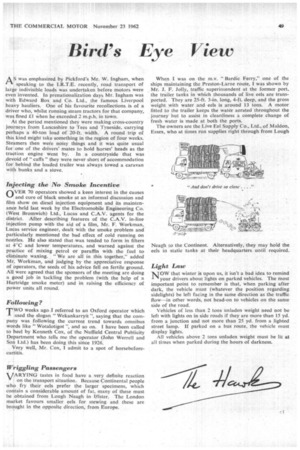Bird's Eye View
Page 51

If you've noticed an error in this article please click here to report it so we can fix it.
As was emphasized by Pickford's Mr. W. Ingham, when speaking to the I.R.T:E. recently, road transport of large indivisible loads was undertaken before motors were even invented. In prenationalization days Mr. Ingham was with Edward Box and Co. Ltd., the famous Liverpool heavy hauliers. One of his favourite recollections is of a driver who, whilst running steam tractors for that company, was fined 1 when he exceeded 2 m.p.h in town.
At the period mentioned they were making cross-country journeys from Lancashire to Tees and Tyneside, carrying perhaps a 40-ton load of 20-ft. width. A round trip of this kind might take something in the region of four weeks. Steamers then were noisy things and it was quite usual for one of the drivers' mates to hold horses' heads as the traction engine went by. In a countryside that was slevoid of "caffs " they were never short of accommodation for behind the loaded trailer was always towed a caravan with bunks and a stove.
Injecting the No Smoke Incentive
OVER 70 operators showed a keen interest in the causes and cure of black smoke at an informal discussion and film show on diesel injection equipment and its maintenance held last week by the Electromobile Engineering Co. (West Bromwich) Ltd., Lucas and C.A.V. agents for the district. After describing features of the C.A.V. in-line injection pump with the aid of a film, Mr. F. Workman, Lucas service engineer, dealt with the smoke problem and particularly mentioned the bad effect of cold running on nozzles. He also stated that wax tended to form in filters at 4°C and lower temperatures, and warned against the practice of mixing petrol or paraffin with the fuel to eliminate waxing. "We are all in this together," added Mr. Workman, and judging by the appreciative response of operators, the seeds of his advice fell on fertile ground. All were agreed.that the sponsors of the meeting are doing a good job in tackling the problem (with the help of a Hartridge smoke meter) and in raising the efficiency of power units all round.
Following?
TWO weeks ago I referred to an Oxford operator which
used the slogan " Wekankarryit ", saying that the company was following the current trend towards omnibus words like " Wotalotigot ", and so on. I have been called to heel by Kenneth Cox, of the Nuffield Central Publicity Department who tells me the operator (John Werrell and Son Ltd.) has been doing this since 1926.
Very well, Mr. Cox, I admit to a spot of horsebeforecartitis.
Wriggling Passengers
VARYING tastes in food have a very definite reaction on the transport situation. Because Continental people who fry their eels prefer the larger specimens, which contain a considerable amount of fat, many of these must be obtained from Lough Neagh in Ulster. The London market favours smaller eels for stewing and these are brought in the opposite direction, from Europe.
When I was on the rn.v. " Bardic Ferry," one of the ships maintaining the Preston-Larne route, I was shown by Mr. J. F. Jolly, traffic superintendent at the former port, the trailer tanks in which thousands of live eels are transported. They are 25-ft. 3-in. long, 4-IL deep, and the gross weight with water and eels is around 13 tons. A motor fitted to the trailer keeps the water aerated throughout the journey but to assist in cleanliness a complete change of fresh water is made at both the ports.
The owners are the Live Eel Supply Co., Ltd., of Maldon, Essex, who at times run supplies right through from Lough Neagh to the Continent. Alternatively, they may hold the eels in static tanks at their headquarters until required.
Light Law NOW that winter is upon us, it isn't a bad idea to remind your drivers about lights on parked vehicles. The most important point to remember is that, when parking after dark, the vehicle must (whatever the position regarding sidelights) be left facing in the same direction as the traffic flow—in other words, not head-on to vehicles on the same side of the road.
Vehicles of less than 2 tons unladen weight need not beleft with lights on in side roads if they are more than 15 yd. from a junction and not more than 25 yd. from a lighted street lamp. If parked on a bus route, the vehicle must display lights.
All vehicles above 2 tons unladen weight must be lit at all times when parked during the hours of darkness.








































































































